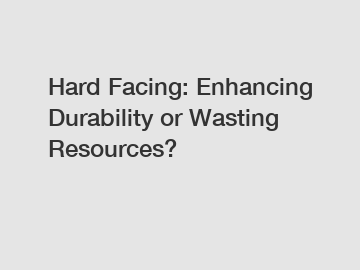Hard Facing: Enhancing Durability or Wasting Resources?
Hard Facing: Enhancing Durability or Wasting Resources?
In the world of manufacturing and engineering, hard facing has become a popular technique to enhance the durability and lifespan of various metal components. This process involves applying a layer of hard material onto the surface of a softer metal, creating a protective shield that can withstand wear, abrasion, and corrosion. However, while hard facing offers undeniable benefits in terms of strengthening and prolonging the lifespan of components, one question arises: are we effectively enhancing durability or simply wasting resources?
To evaluate whether hard facing is a cost-effective and environmentally sustainable approach, we must carefully consider several aspects.

Firstly, let us explore the concrete advantages of hard facing. One of its key benefits is enhanced durability. By adding a tough layer to susceptible surfaces, manufacturers can significantly increase the lifespan of components, reducing the need for frequent replacements and repairs. This not only reduces costs in the long run but also minimizes downtime and increases productivity. Moreover, hard facing can greatly improve the performance of certain parts, allowing them to withstand extreme conditions, such as high temperatures or intense friction.
However, it is crucial to consider the environmental impact of hard facing. The process typically involves using materials like carbides, ceramics, or metal alloys, which are not always readily available and require mining or extraction. This raises concerns about resource depletion and the destruction of natural habitats. Additionally, the production of these materials often involves energy-intensive processes, generating greenhouse gas emissions that contribute to climate change.
To strike a balance between enhancing durability and conserving resources, it is essential to adopt a sustainable approach to hard facing. One way to achieve this is by optimizing the application process and material usage. Proper planning and analysis can help determine the optimal thickness and composition of the hard facing layer to minimize material waste. Techniques like thermal spraying or laser cladding can also be utilized to reduce material usage while achieving the desired durability.
Recycling and reusing hard facing materials is another avenue to consider. After a component reaches the end of its useful life, the hard facing layer can be stripped off and recycled, reducing the need for new materials. This not only conserves resources but also reduces the waste generated during the manufacturing process. Additionally, advancements in material science and technology are increasing the potential for using recycled or eco-friendly hard facing materials, further reducing the environmental impact.
Collaboration and knowledge sharing among manufacturers and industries are crucial to further enhance the sustainability of hard facing. By sharing best practices, innovative approaches, and success stories, the industry can collectively work towards minimizing resource consumption, optimizing material usage, and exploring alternative materials. Furthermore, ongoing research and development efforts should focus on creating new materials or techniques that offer comparable or even superior durability while reducing environmental impact.
In conclusion, the question of whether hard facing enhances durability or wastes resources requires a careful evaluation of various factors. While hard facing undeniably enhances the durability and performance of components, its environmental sustainability is a concern. However, by adopting sustainable practices, optimizing material usage, recycling, and exploring alternative options, we can strike a balance between durability enhancement and resource conservation. Consequently, hard facing can be a valuable technique that not only extends the lifespan of components but also contributes to a more sustainable future for the manufacturing industry.
For more Chromium Carbide Wear Plate, what is chromium carbide overlay, carbide wear plate supplierinformation, please contact us. We will provide professional answers.

Comments